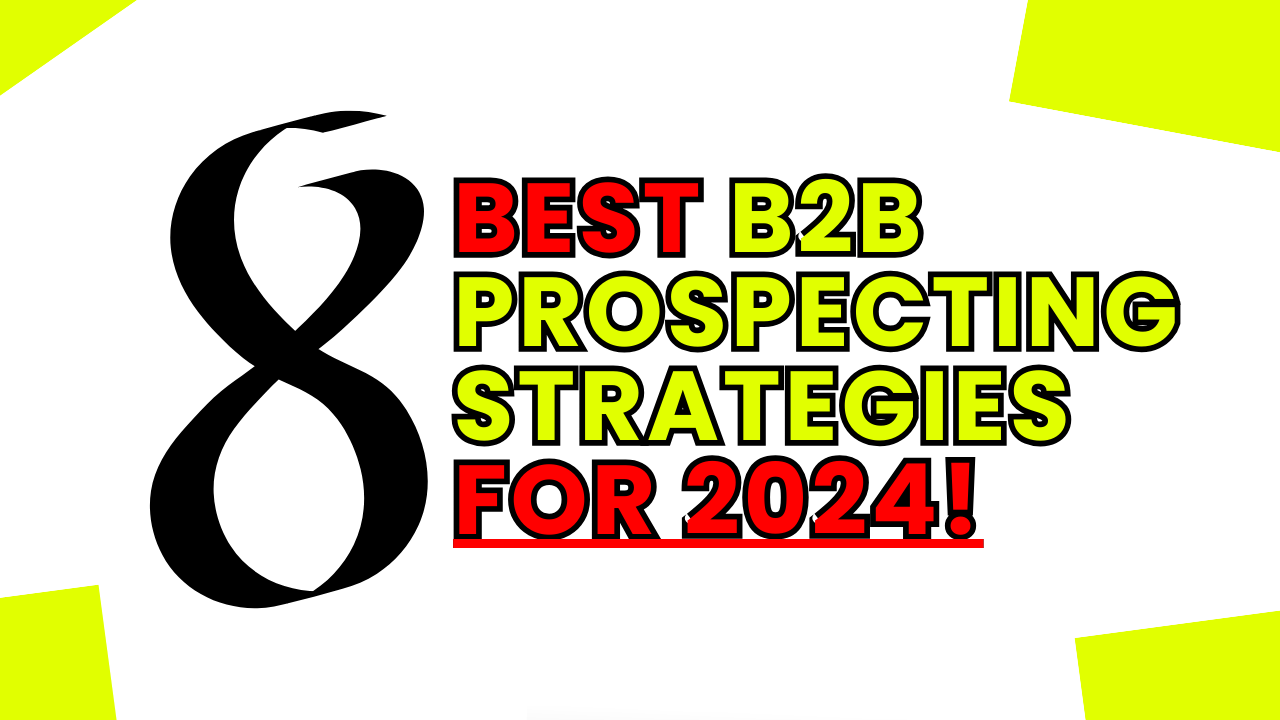In B2B sales, prospecting is important.
We all know that, however…
In the haste of chasing leads, meeting quotas, and achieving sales goals, we more often than not overlook its foundational role.
It’s a common trap most businesses fall into: waiting until the sales pipeline thins out before ramping up prospecting efforts.
But in the crazy business world of 2024, where B2B sales strategies are continuously evolving, staying ahead means adopting the best ones and doing them the best.
That’s why we decided to share with you 8 best B2B prospecting strategies for 2024 and how to use them to exceed your sales goals.
Ready to dive in?
Channel your attention and let’s get started.
Summary
In this blog guide, we’re exploring the top eight B2B prospecting strategies for 2024.
We’re not just listing them, no. We’re diving deep.
Each strategy is broken down to its core, making it easy for you to implement them effectively to boost your sales results immediately.
We’ll go over what, why, and how (and what not) leaving no stones unturned.
From understanding your customer profiles to mastering the art of social selling and inbound marketing, each strategy is a piece of the puzzle in building a robust sales pipeline.
So whether you’re looking to refine your existing sales approach or seeking fresh tactics, this article is your roadmap to mastering B2B prospecting in 2024.
Let’s roll up our sleeves and explore these game-changing prospecting strategies.
What is B2B Prospecting?
B2B prospecting is the process of identifying, researching, reaching, and engaging potential customers (prospects) with the aim of converting them into paying customers.
It’s the bedrock of any sales strategy, vital for keeping your sales pipeline healthy and your revenue stream flowing.
And yes, sales prospecting is much more than just finding names and numbers.
Prospecting is about understanding:
- who your potential customers are,
- what they need,
- how your product or service fits into their world,
- how to reach them,
- and how to communicate your UVP in the most effective way.
It’s about sifting through tons of data, doing a bunch of research, and doing a lot of outreach while, at the same time, facing rejection, refining your approach, and keeping your sales pipeline flowing.
Sounds easy, right?
Jokes aside, B2B prospecting isn’t a walk in the park and it’s not for the faint of heart but since you are here we guess you are serious about crushing it and we’ll help you do that!
Before we proceed, let’s look at how B2B prospecting would look like in action:
Imagine you’re selling CRM software to small businesses.
Sales prospecting in this scenario involves sifting through data, like attendee lists from a recent webinar or your LinkedIn Sales Navigator saved lead list.
Here it’s all about finding those gems in the data – businesses that might need what you offer.
Your team digs deeper, looking at factors like company size, industry, and recent changes that might signal a need for your product, in this case, CRM software.
Then comes the outreach.
Maybe it’s a cold call to a freshly funded startup, an email campaign to webinar attendees, or targeted digital ads to those who’ve interacted with your content.
It doesn’t matter which B2B prospecting strategy you’ll go with, each interaction is tailored, hitting the right notes – features your audience needs for the problems they are facing.
In essence, B2B prospecting is this strategic, targeted approach:
- knowing who your audience,
- understanding their needs,
- reaching out
- and engaging in a way that resonates.
It’s the critical first step toward that end goal: closing a sale.
B2B prospecting is the beginning of a journey that, when done right, leads to a fruitful partnership.
What is a B2B Prospecting Strategy?
B2B prospecting strategy is a strategy you choose to identify, research and engage potential customers in the B2B sphere.
Just as a skilled chef has different recipes for different occasions, a savvy sales rep has a variety of B2B prospecting strategies in their arsenal.
These prospecting strategies vary in approach, technique, and execution but share a common goal: to convert prospects into loyal paying customers.
And, of course, you should use mix them up for the best results.
Before we proceed, it’s important to let you know that in this blog, we’re not just skimming the surface as other blogs you might stumble on.
No.
We’re diving into the best of the best B2B prospecting strategies and sharing with you everything you need to know to make them work for you.
Cool?
Cool, let’s continue with the main topic of this article.
8 Best B2B Prospecting Strategies for 2024
2023 has been a year where the B2B prospecting game has seen some serious shifts.
With the world constantly changing, what worked yesterday might not cut it today.
But don’t worry, we’re not here to rehash old sales tactics.
We’re here to focus on what’s working right now.
In the coming sections, we’ll delve into the strategies that have proven their worth in the trenches of B2B sales last year.
These aren’t just theoretical ideas – they’re real, actionable prospecting strategies that have been put to the test and have come out on top.
So, if you’re ready to learn about the sales strategies that are setting the pace in 2024, stay tuned.
We’re about to unpack the ones that are not just trendy, but truly effective.
Prospecting Strategy #1 Understand your Ideal Customer Profiles and Buyer Personas
The first and arguably most crucial step in B2B prospecting is understanding your ideal customer profiles (ICPs) and buyer personas.
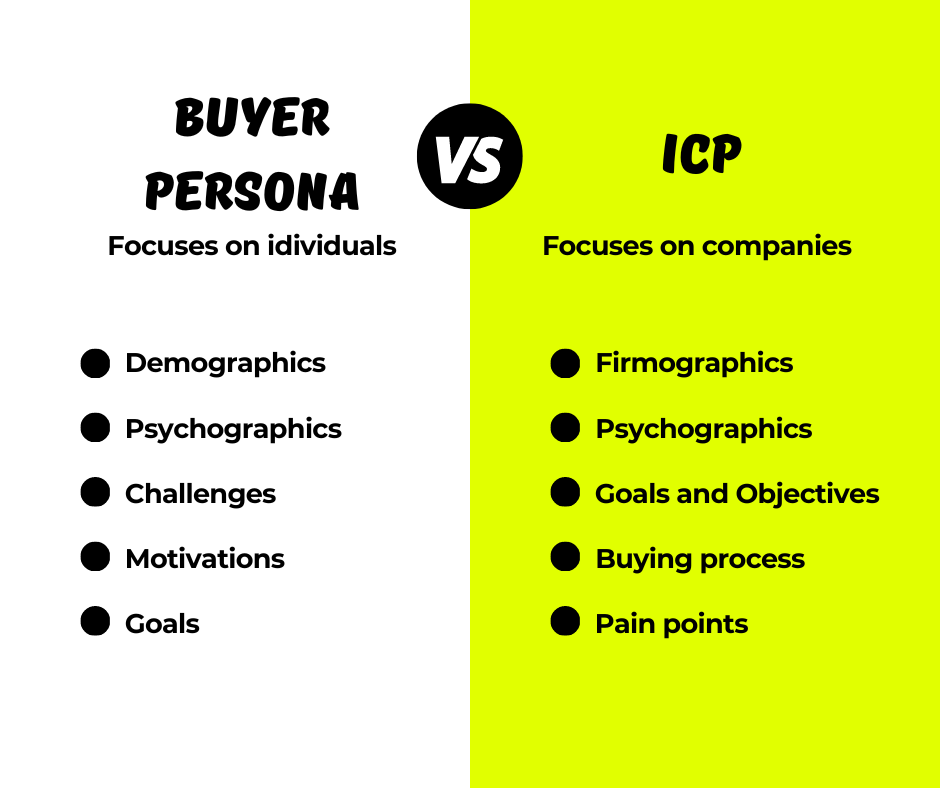
This isn’t just about who might buy your product, it’s about understanding who should buy your product.
Mess this up and no matter what you do, you won’t be able to sell anything simply because you are targeting the wrong organization and the wrong people inside of them.
You won’t try to sell a fishing rod to a deer hunter right?
And even if you are crazy enough to try, you probably won’t sell many.
So here’s a detailed how-to to help you create and implement these profiles effectively.
The Essence of ICPs and Buyer Personas
Ideal Customer Profile (ICP) – This is a comprehensive description of the businesses that would benefit most from your product or service. It’s a blueprint of your ‘perfect customer’ and includes elements like:
- Firmographics (Company size, Industry, Location, Annual revenue, etc)
- Psychographics (Values, Preferences, Company culture)
- Goals and Objectives (Short and long-term goals)
- Pain points (list of problems your ideal customer is facing)
- Buying process (research, evaluation criteria, decision-making process, who is involved, budget, influencers)
Buyer Persona – While your ICP represents ideal companies, Buyer Personas zoom in on the ‘ideal’ individuals – buyers, decision-makers, and influencers – within these companies. These semi-fictional characters represent your ideal customer and consist of:
- Demographics/Background (Age, Income, Location, Job, Career Path, Lifestyle, etc)
- Goals (Primary/Secondary, Personal & Professional, Motivations, Top metrics they track)
- Challenges (What keeps them up at night? What obstacles are preventing them from achieving their goals?)
- Personality (are they creative, friendly, analytical, introvert/extrovert, etc)
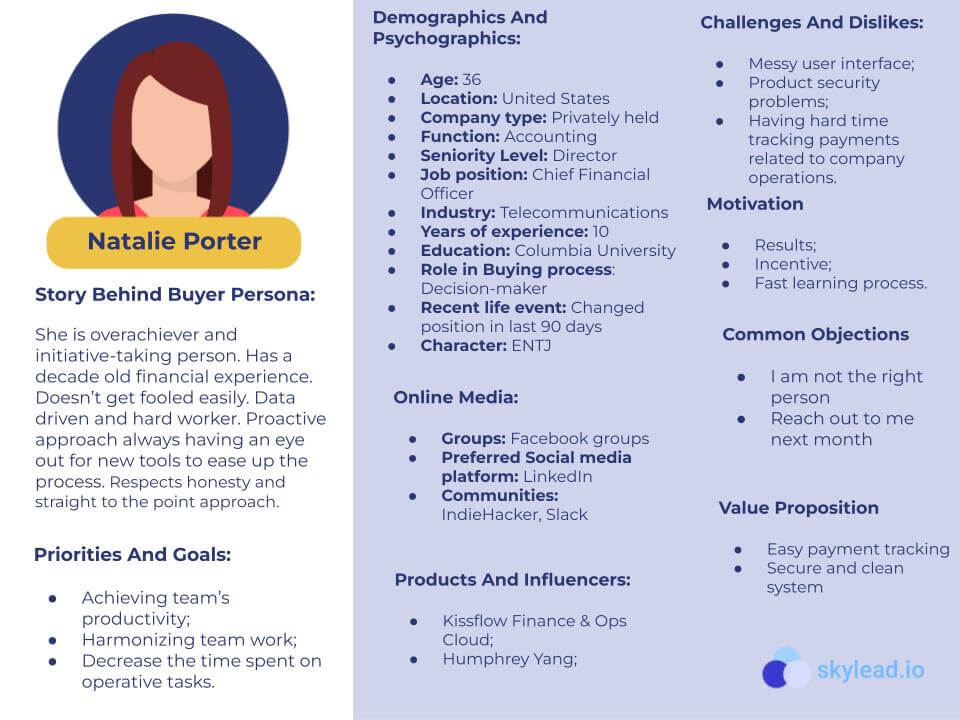
Developing Your ICPs and Buyer Personas
1. Data Gathering
Start with your existing customer base (if you have one)
Who are your best customers? What do they have in common?
Use data analytics tools and CRM software to analyze patterns in purchasing behavior, feedback, and engagement.
If you don’t have an existing customer base you have to rely on market and industry research and hypotheses.
2. Create Detailed Profiles and Personas
For ICPs, map out their industry dynamics, size (number of employees, annual revenue), their market position (are they leaders, followers?), and what specific problems they look to solve.
For Buyer Personas, get into their heads. What does their typical day look like? What challenges do they face in their role? What are their professional aspirations? How do they consume information (blogs, social media, webinars)?
3. Regular Use and Review
Apply these insights across all sales and marketing activities.
What’s the point of having them if you never use them?
Customize your sales pitches, marketing messages, and content strategy to address the specific challenges and needs identified in your profiles.
Regularly revisit and revise these profiles as markets and customer behaviors evolve.
Implementation and Timing
Implement this strategy at the very beginning of your prospecting process.
Before any sales outreach or campaign, make sure your team is fully aligned on who they are targeting and why.
You should also revisit and refine your ICPs and Buyer Personas every quarter as markets change, new challenges emerge, and staying updated is key.
Common Mistakes to Avoid
1. Too Broad or Vague – “All SMEs” isn’t a target market. Be specific. The more detailed you are, the more targeted your sales strategy can be.
2. Ignoring Data – Your existing customers are a goldmine of information. Lean on data, not just intuition.
3. Ignoring the Decision-Making Unit (DMU) – In B2B, purchases are rarely a one-person decision. Understand the dynamics of the DMU – who are the influencers, gatekeepers, and decision-makers?
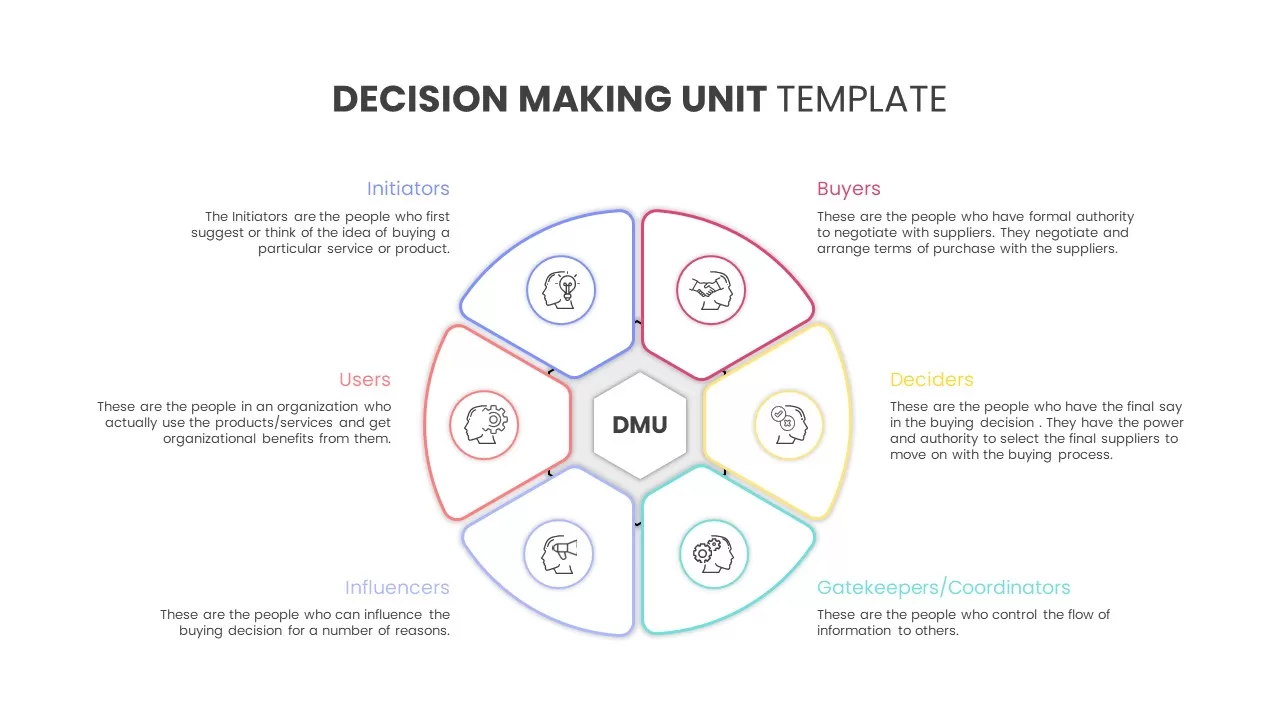
4. Overlooking the Buyer’s Journey – Different personas engage at various stages of the buyer’s journey. Customize your approach to meet them where they are.
5. Neglecting the Personal Touch – B2B doesn’t mean emotionless. People make decisions, not companies. Understand the individual’s challenges and aspirations.
Summary
In essence, understanding your ICP and buyer personas isn’t just a box to tick off in your prospecting checklist.
It’s an ongoing, evolving strategy that keeps you aligned with the market and your customers’ evolving needs.
Get this right, and your prospecting efforts will be more focused, more effective, and ultimately more successful.
Prospecting Strategy #2 Prequalifying B2B Prospects
After nailing down your Ideal Customer Profiles and Buyer Personas, the next vital strategy in your B2B prospecting toolkit is prequalifying prospects.
This is where you sift through potential leads to pinpoint those most likely to convert into sales.
It’s like panning for gold – separating the real prospects from the dirt.
Why you should prequalify B2B prospects?
Prequalifying is essential because even if the prospect fit the description of the ICP and buyer persona and your solution is perfect for them, it doesn’t mean they will be interested.
That’s normal.
Maybe they are using your competitor, maybe the recession affected their company, maybe they don’t see the value in it.
Whatever the case may be, prequalifying B2B prospects helps with this, saving you time and energy, and allowing your sales team to focus on leads with the highest conversion potential.
This is being smart with your resources, not just hardworking.
How to Prequalify
1. Initial Research
First, we want to make sure the prospect fits our ICP.
Do they fit the profile?
Are they in the right industry, are they big enough, and do they have the pain points your product solves?
2. Budget and Authority
Do they have the budget and decision-making power?
No point in pitching to someone who can’t say yes.
3. Need and Timing
Are they in need of your solution now, or is it a future consideration?
Timing can make or break a deal.
4. Engagement Level
Assess their engagement with your brand.
Have they interacted with your content, visited your website, or responded to previous outreach?
5. Use Scoring Systems
Implement a lead scoring system to prioritize prospects based on how well they match your criteria.
It adds a layer of objectivity to the process.
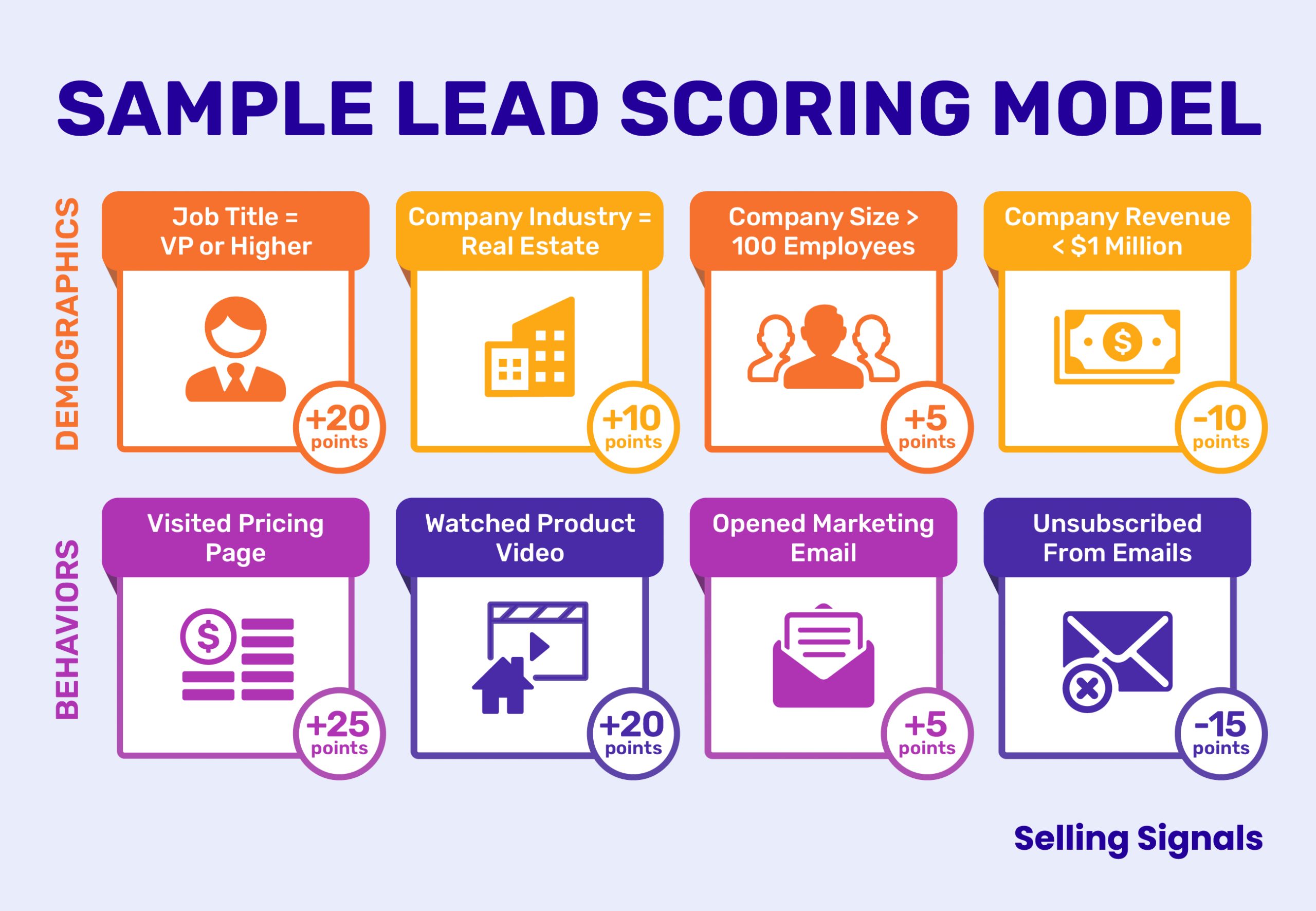
Timing is Everything
Integrate prequalification early in your prospecting process.
It should be one of the first steps post-identification of a potential lead.
This ensures you’re allocating resources to the most promising prospects from the get-go.
Common Slip-Ups to Sidestep
1. Skipping Research – Jumping straight into sales outreach without prequalifying leads to wasted efforts.
2. Relying Solely on Gut Feeling – Data should drive decisions, not just intuition.
3. Ignoring Non-Decision Makers – They might not sign the check, but influencers and gatekeepers can sway decisions.
4. Rigid Criteria – While criteria are important, be flexible. Sometimes, the most lucrative prospects don’t tick every box but show great potential.
5. Ignoring the Power of ‘No’ – Not every lead will qualify, and that’s okay.
Learning to accept and move on from unqualified leads is crucial.
Summing It Up
In the end, prequalifying prospects is about efficiency.
It’s about making sure every call you make, every email you send, is targeted and has the highest chance of success. It’s not just a step in the process – it’s a strategic move that sets the tone for your entire prospecting journey.
Prospecting Strategy #3 Cold Calling
Cold calling, often viewed as an old-school tactic, still holds its ground in 2024 as a powerful B2B prospecting strategy.
Sure, it’s challenging, but when done right, it can open doors that other strategies can’t.
Why Cold Calling Still Works?
Despite the digital revolution, a well-placed phone call can cut through the noise faster than an email, ad, or DM.
And the reason for that is simple: we are humans after all, and as humans, we do business with those we know, like, and trust, and a phone call is something that allows us to get to know someone, like them, and trust them in the fastest way possible.
Plus as the world gets more digital, we crave human connection more and more.
No matter how logical this is, we don’t drive conclusions based on logic alone, we drive it from results, so here are some stats that show how effective cold email is even today:
- 17% of B2B marketers use cold calling as their main customer acquisition channel.
- 57% of C-level and VP buyers across industries prefer the phone call, versus directors (51%) and managers
- 54% of technology buyers prefer being contacted by cold call, 40% of buyers in financial services and 50% of purchasing decision-makers in professional services.
How to Make Cold Calling Work for You?
1. Prepare Thoroughly
Before you dial a lead, know who you’re calling.
Understand their business, their challenges, and how your solution fits in.
This isn’t just about not calling a vegetarian restaurant to sell steak, it’s about knowing what specific challenges the person on the other end of the line faces.
2. Script It, But Don’t Rely on It
Have a script to guide the conversation, but be ready to go off-script.
The script is your safety net, not your crutch.
It’s there to guide you, not confine you.
3. Value Proposition Front and Center
Within the first few seconds of the cold call, your prospect should know why they’re talking to you.
What’s in it for them?
Make it clear, make it compelling.
4. Handle Objections Gracefully
Objections are not rejections.
They’re opportunities to understand the prospect’s concerns and address them.
5. Follow Up
It often takes multiple calls to make a breakthrough.
Don’t be discouraged by initial lead rejections.
Persistence, coupled with respect for the prospect’s time, is key.
Common Pitfalls to Avoid
1. Skipping Pre-Call Research – Cold calling without context is like shooting in the dark.
2. Overwhelming With Information – Keep your message clear and concise. Don’t bombard them with too much too soon.
3. Neglecting Follow-Up – If a prospect shows interest, follow up. A call without follow-up is an opportunity missed.
4. Ignoring Feedback – Pay attention to the responses you get, both positive and negative. This feedback is invaluable for refining your approach.
In Summary
Cold calling in 2023 is about being human in a digital world.
It’s about creating connections, understanding needs, and offering solutions.
It’s challenging, no doubt, but when done right, it’s incredibly effective.
So pick up that phone, be prepared, be personable, and start dialing.
The results might just surprise you.
Prospecting Strategy #4 Outbound Emails
Outbound emails are a staple in the B2B prospecting toolbox. They’re efficient, scalable, and when done right, can yield impressive results. In 2024, emails continue to be a vital channel for reaching out to potential clients.
Why Outbound Emails Are Effective?
Emails allow you to reach prospects directly in their inbox, a place most professionals check multiple times a day. It’s a direct line of communication that, unlike social media or ads, doesn’t depend on algorithm changes or platform policies. Plus, they offer the flexibility to be both personal and professional.
Recent Statistics to Consider
- 43% of salespeople say that email is the most effective sales channel
- 80% of buyers prefer to be contacted by email
- 71% buyers are open to receiving emails when they’re looking for new solutions to drive better business results
Crafting Emails That Get Opened and Read
1. Subject Line is Your Headline
The subject line decides whether your email gets opened or ignored.
Make it intriguing, relevant, and to the point.
2. Personalization is Key
Generic blasts are a no-go.
Use the prospect’s name, reference their company, and make it clear you’ve done your homework.
3. Value-Driven Content
Your email should offer something of value.
Whether it’s an insightful article, a helpful tip, or an invitation to a webinar, make sure it’s relevant to their needs.
4. Strong Call to Action (CTA)
What do you want them to do next? Schedule a call? Visit your website?
Be explicit and make it easy for them to take the next step.
5. Mobile-Friendly Design
With more and more people checking emails on their phones, ensure your emails look good and read well on mobile devices.
Avoid These Common Email Mistakes
1. Overloading with Content – Keep it concise. A long-winded email is likely to be ignored.
2. Ignoring Segmentation – Tailor your emails to different segments of your audience for better engagement.
3. Forgetting to Test – A/B testing subject lines, content, and CTAs can significantly improve your open and click rates.
4. Neglecting Email List Hygiene – Regularly clean your email list to maintain its quality and deliverability.
5. Being Too Salesy – Your email should offer value, not just push for a sale. Educate, inform, and engage.
6. Not Tracking Performance – Use analytics to track opens, clicks, and conversions. This data is crucial for refining your strategy.
To Wrap It Up
In a world where inboxes are constantly flooded, standing out with outbound emails requires a mix of personal touch, relevance, and timing.
Do it right, and you’ll not just capture their attention, you’ll start a conversation that could lead to your next big sale.
So, craft each email like it’s the only one your prospect will read today.
Because it just might be.
Prospecting Strategy #5 Social Selling
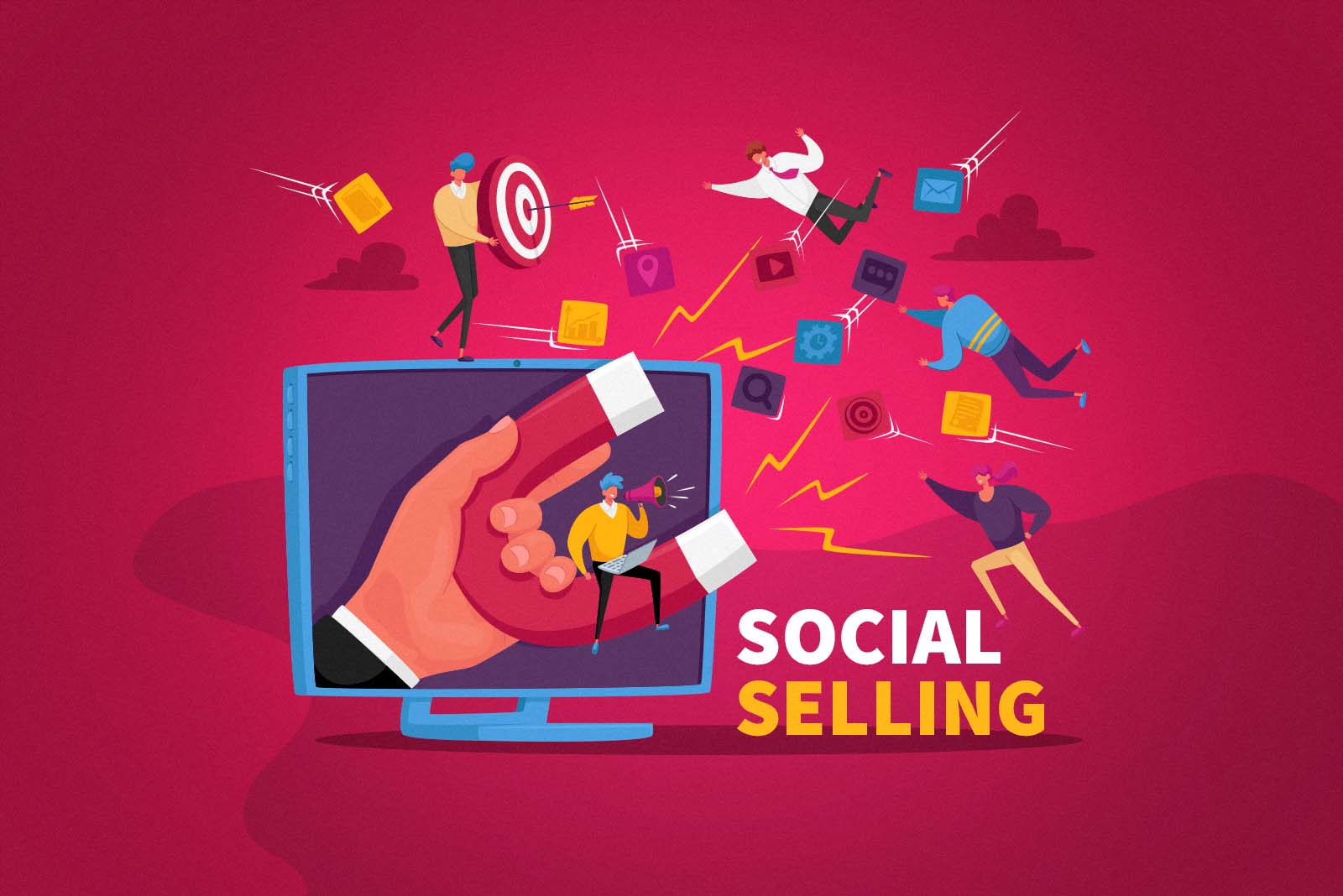
Social selling, a modern twist in the B2B prospecting playbook, leverages social media to connect, engage, and close deals.
In 2024, it’s not just about being on social platforms, it’s about strategically using them to build relationships and drive sales.
Why Social Selling?
In an era where almost everyone is digitally connected, social selling lets you meet prospects where they already are: on social media platforms.
It’s a goldmine for understanding your prospects’ interests, challenges, and industry trends.
But. more importantly, it’s a great place to find, engage, and even sell to them.
Stats to Keep in Mind:
- 78% of social sellers outsell peers who don’t use social media.
- 31% of B2B professionals say that social selling allowed them to build deeper relationships with clients.
- Social selling leaders are 51% more likely to reach quota.
- LinkedIn is the most effective platform for B2B social sellers, with over 80% finding it helpful.
Mastering Social Selling
1. Choose the Right Platforms
LinkedIn, for instance, is a powerhouse for B2B prospecting. Find out where your prospects are most active and focus your efforts there.
2. Build a Strong Profile
Your profile is your digital handshake.
Make it professional, authentic, and engaging.
Show your expertise and how you can help solve problems.
3. Share Valuable Content
Post and share content that adds value to your audience.
It could be industry insights, helpful tips, or success stories.
The goal is to establish yourself as a thought leader.
4. Engage, Don’t Just Broadcast
It’s about dialogue, not monologue.
Comment on posts, answer questions, and engage with content relevant to your industry.
5. Build Relationships
Connect and engage with potential customers, industry leaders, and influencers.
Genuine relationships are the foundation of effective social selling.
6. Combine with Other Strategies
Social selling works best when combined with other strategies like email and cold calling.
Common Mistakes in Social Selling to Avoid
1. Hard Selling – It’s social selling, not social advertising. Focus on building relationships, not just pushing your product.
2. Inconsistent Activity – Being active one day and disappearing for weeks won’t work. Consistency is key.
3. Ignoring Social Listening – Pay attention to what your prospects and industry leaders are saying. It’s invaluable for understanding market needs.
4. Failing to Follow Up – If a prospect shows interest, take the conversation off social media. Schedule a call or a meeting.
5. Not Measuring Impact – Track your activities and their outcomes. Understanding what works (and what doesn’t) is key to refining your sales approach.
In a Nutshell
Social selling in 2024 is about being where your customers are and engaging with them in meaningful ways.
It’s a powerful tool in your prospecting arsenal, enabling you to build credibility, trust, and ultimately, valuable business relationships.
Do it right, and you’ll not only connect with prospects, but you’ll also set the stage for long-term partnerships.
Prospecting Strategy #6 Sales Cadences
Sales cadences, the rhythmic sequence of outreach activities, are the backbone of a structured B2B sales prospecting strategy.
Think of it as a choreographed dance of emails, calls, and social interactions, all timed perfectly to engage potential customers.
Understanding Sales Cadences
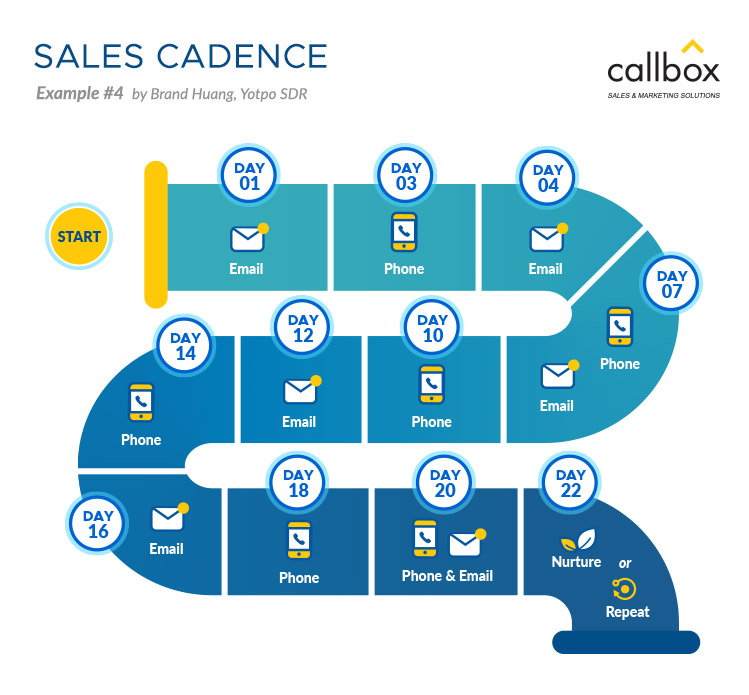
A sales cadence is your plan of action for how and when you’ll reach out to prospects and in the chaos of sales they bring order.
They ensure consistent, strategic outreach, creating a rhythm that keeps you on your prospect’s radar without overwhelming them.
Think of it as the blueprint that keeps you from being too pushy or too passive.
Building an Effective Sales Cadence
1. Mix It Up
Your cadence should include a blend of emails, calls, and social media interactions.
Variety keeps your outreach fresh and engaging.
2. Timing Is Key
Set a regular schedule for your outreach.
For instance, start with an introductory email, follow up with a call two days later, then a LinkedIn message after another three days.
3. Personalize Your Approach
Tailor your messages to reflect the prospect’s industry, role, and any interactions they’ve had with your company brand.
4. Monitor and Adjust
Pay attention to how prospects respond to different types of communication and at what stages of the sales funnel.
Use this data to refine your cadence.
5. Persistence Pays Off
An effective sales cadence might span several weeks or even months.
Don’t give up too early, but also know when it’s time to move on.
Recent Stats:
- It takes an average of 8 touches to get an initial meeting with a new prospect.
- Best performing sales reps use a cadence with 8-12 touchpoints over a 2-4 week period.
- Adding 1 follow-up in your sales prospecting sequence can increase new leads by 28%.
Common Cadence Mistakes
1. One-Size-Fits-All – Avoid using the same sales cadence for every prospect. Adapt based on company industry, company size, and buyer persona.
2. Neglecting Follow-Up – The magic often happens in the follow-up. Don’t let sales prospects slip through the cracks.
3. Overlooking Data – Use analytics to track which touchpoints are working and which aren’t. Adjust your sales strategy accordingly.
4. Ignoring Prospect Feedback – If a prospect indicates they’re not ready or interested, respect their position and adjust your sales outreach.
5. Forgetting to Add Value – Each interaction should offer something valuable – be it information, insights, or solutions.
To Conclude
Sales cadences are more than just a schedule of calls and emails.
They’re a strategic way to nurture relationships over time.
By implementing a well-thought-out sales cadence, you ensure regular, relevant, and respectful communication with your prospects.
Done right, it’s a powerful tool in moving leads through your sales funnel and toward that all-important sale.
Prospecting Strategy #7 Paid Advertisement
Paid advertisement in the B2B arena is like a high-powered spotlight.
It illuminates your brand to the right audience, at the right time, and in the right places.
When harnessed effectively, paid ads can supercharge your prospecting efforts and fill your funnel with quality leads.
Why Paid Advertisement?
Paid ads offer a level of precision targeting that other strategies can’t match.
You can zero in on prospects based on their industry, job title, online behavior, and even specific challenges they face.
This precision ensures that your investment is directed towards leads most likely to convert.
Implementing a Successful Paid Ad Strategy
1. Identify Your Target Audience
This goes back to knowing your ICP and buyer personas.
Tailor your ad audience to those who are most likely to be interested in your product or service.
2. Choose the Right Platforms
LinkedIn, for example, is fantastic for B2B.
Google Ads and industry-specific platforms can also be effective.
The key is to be where your prospects are.
3. Craft Compelling Ad Copy and Creatives
Your ad should grab attention and convey value quickly.
Use clear, concise messaging and visuals that resonate with your target audience.
4. Set a Budget and Monitor ROI
Start with a budget you’re comfortable with and track your return on investment (ROI) meticulously.
This helps in fine-tuning your strategy and spending.
5. Test and Optimize
Run A/B tests on different elements like ad copy, images, and call-to-actions.
Use the insights to optimize for better performance.
Recent Statistics:
- B2B companies that use paid ads see an average of 200% ROI.
- Retargeting ads have a 70% higher conversion rate compared to standard ads.
- 41% of clicks go to the top three paid ads in search results
Avoid These Paid Ad Pitfalls
1. Vague Targeting – Broad targeting can lead to wasted spend. Hone in on specific segments for better results.
2. Ignoring Landing Page Experience – Your ad is only as good as the landing page it leads to. Ensure your landing pages are optimized for conversion.
3. Overlooking Ad Fatigue – If you’re using the same ads over a long period, they might stop resonating. Refresh your creative regularly.
4. Forgetting Mobile Optimization – Many B2B decision-makers use mobile devices. Make sure your ads and landing pages are mobile-friendly.
5. Not Adapting to Feedback – If an ad isn’t performing well, don’t be afraid to change it. The digital ad space is dynamic, and so should be your approach.
In Essence
Paid ads in B2B prospecting are about strategic visibility.
It’s a method that, when done correctly, can efficiently funnel high-quality leads into your sales pipeline.
By focusing on targeted messaging, appropriate platforms, and continuous optimization, your paid ad strategy can become a powerhouse in your overall prospecting efforts.
Prospecting Strategy #8 Inbound marketing
Inbound marketing in the B2B world is like building a magnet. It’s about creating content and experiences tailored to attract and engage your ideal customers, pulling them towards your brand naturally and effectively.
Why Inbound Marketing is Essential

Inbound marketing focuses on creating value for your prospects.
Instead of pushing sales messages out, it draws potential customers in with useful, relevant content.
This approach builds trust and positions your brand as an authority, which is key in the B2B space where decisions are often complex and research-driven.
Inbound marketing works because it aligns with the modern buyer’s behavior.
Today’s B2B buyers do their homework.
They research, read, and form opinions long before they speak to a sales rep.
Inbound marketing ensures you’re part of their research process.
Implementing a Strong Inbound Marketing Strategy
1. Create Valuable Content
Develop blog posts, whitepapers, e-books, and videos that address your prospects’ pain points, interests, challenges, and questions
This content should educate, inform, and engage your audience.
2. SEO Matters
Optimize your content for search engines.
Use keywords that your prospects are likely to search for.
Remember, being found online is half the battle won.
3. Leverage Social Media
Share your content on social media platforms where your sales prospects spend time.
Use it to engage in conversations and build relationships.
4. Email Marketing
Use email newsletters to share your latest content with your subscribers.
Make it valuable enough that they look forward to receiving it.
Content Marketing Stats:
- Content marketing gets three times more leads than paid search advertising.
- B2B companies with blogs generate 67% more leads per month than those without.
- 62% of B2B buyers make purchase decisions based solely on the content they consume.
- 91% of buyers prefer to consume content online before making a purchase decision.
Common Inbound Marketing Mistakes to Avoid
1. Irrelevant Content – Your content should speak directly to the needs and interests of your target audience. Irrelevant content won’t attract the right leads.
2. Neglecting SEO – If your content isn’t optimized for search engines, it’s like a billboard in the desert. Make sure it’s discoverable.
3. Forgetting Mobile Optimization – A significant portion of B2B research is done on mobile devices. Make sure your content is mobile-friendly.
4. Not Measuring ROI – Track the performance of your content to understand what’s working and what’s not. Adjust your strategy based on these insights.
To Sum Up
Inbound marketing in B2B is a long game and it doesn’t bring results as fast as other sales prospecting strategies we discussed, however, once it starts working it can get you quality leads on autopilot.
When executed well, not only does it attract prospects but also converts them into loyal customers, setting the stage for sustainable business growth, which is why this is a must-have for B2B in 2024.
How can ZeroIn help you achieve your Sales Goals?
If you’ve spent more than a minute on the internet reading about prospecting and getting leads, you’ve probably come across advice from gurus and influencers telling you to focus on quality over volume.
But let’s be real here: the fastest and best way to get results is by focusing on both. You need a heap of leads, and you need them to be good.
Now, one way to get a bunch of leads is to buy a list, like our VP email list, where you get exactly what you need: name, verified business email, profession, job title, industry, website, LinkedIn, Twitter, and company details.
But if buying a list isn’t in the cards for you (though you can snag our free samples), you’ll need to find leads manually.
There are countless ways to do that, but let’s skip the basics.
Once you find those leads, then what?
You might stumble upon the ideal company and even find the founder’s name on LinkedIn, but that’s just the tip of the iceberg.
Where do you go from there?
How do you dig deeper?
Just having a name often isn’t enough.
Here’s where smart experts turn to ZeroIn.
ZeroIn isn’t just another tool, it’s a game-changer for your prospecting strategy. It’s a business email finder and data export tool specifically designed for LinkedIn, giving you the edge in lead generation.
Why ZeroIn Rocks:
1. Compelling Data for Campaign Success – ZeroIn provides clean, verified, and actionable data. This isn’t just a list of names and emails. It’s comprehensive data, enriched with business emails verified in real-time, ensuring your cold email outreach and marketing campaigns hit the mark.
2. GDPR Aligned for Peace of Mind – With data privacy being a hot topic, it’s crucial to stay on the right side of regulations. ZeroIn aligns perfectly with GDPR, assuring you that the data you collect is both ethical and compliant.
3. High Accuracy Rate for Reliable Outreach – What’s data without accuracy? ZeroIn boasts a 98% accuracy rate, so you can trust the information you receive. This reliability is invaluable when crafting your outreach strategies.
4. Extensive Data Points for a 360-degree View – With 26 data points on leads and companies, ZeroIn offers a multi-dimensional view of your prospects. This depth of data enables a more targeted and personalized approach to your engagement and nurturing efforts
5. Large Database for Ample Choices – Access to an extensive database of over 200 million contacts opens up a world of possibilities. This vast resource enhances your chances of finding ideal leads, empowering you to scale your outreach and hit your sales targets.
Tying It All Together
As the B2B space gets more and more competitive and buyers get more and more picky, tools like ZeroIn are not just helpful, they’re essential. They bridge the gap between finding a prospect and knowing enough about them to make a meaningful connection.
In a world where information is power, ZeroIn equips you with the arsenal you need to target, engage, and convert prospects into valuable customers.
So why not give yourself this edge in the competitive world of B2B sales?
Gave ZeroIn a try and see why more than 5,000 marketing and sales professionals can’t imagine prospecting without it:
Conclusion
Alright, let’s land this plane.
We’ve gone through a lot, from getting to grips with who your customers really are, to spinning the social media wheel, all the way to getting smart with tools like ZeroIn.
It’s a lot to take in, but here’s the thing: it’s all about mixing it up, trying different things, and seeing what sticks.
Remember, there’s no magic spell in B2B sales.
It’s about rolling up your sleeves, getting your hands dirty, and maybe having a bit of fun along the way.
Whether it’s crafting that perfect email or sliding into DMs on LinkedIn, keep your eye on the prize, but don’t forget to enjoy the ride.
And hey, if you ever feel stuck, just think of it as a game.
A game where the rules keep changing, sure, but that’s what makes it exciting, right?
Keep playing, keep experimenting, and who knows – you might just end up rewriting the rulebook.
FAQs
What is the B2B Prospecting?
B2B prospecting is the process of identifying, researching, reaching, and engaging potential customers (prospects) with the aim of converting them into paying customers.
What is a B2B Prospecting Strategy?
B2B prospecting strategy is a strategy you choose to identify, research and engage potential customers in the B2B sphere.
Which B2B Prospecting Strategies worked best in 2023?
Here are 8 B2B Prospecting Strategies that worked best in 2023:
1. Understand your Ideal Customer Profiles and Buyer Personas
2. Prequalifying Prospects
3. Cold Calling
4. Outbound emails
5. Social Selling
6. Sales Cadences
7. Paid Advertisement
8. Inbound marketing
How can ZeroIn help you achieve your Sales Goals
ZeroIn can supercharge your sales goals by providing a wealth of accurate and actionable data. It’s a tool designed for savvy B2B sales professionals who need reliable information fast. With ZeroIn, you get:
Verified Data: Clean and verified business emails, ensuring your outreach hits the mark.
GDPR Compliance: Ethical and compliant data collection for peace of mind.
High Accuracy: Trustworthy data with a 98% accuracy rate for reliable outreach.
In-Depth Insights: 26 data points on leads and companies for targeted engagement.
Extensive Database: Access to over 200 million contacts, increasing your chances of finding ideal leads.
In short, ZeroIn bridges the gap between finding a prospect and knowing enough about them to make a meaningful connection, helping you convert prospects into valuable customers.
